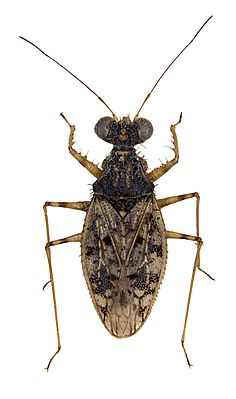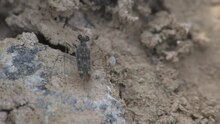Stone runner bugs
| Stone runner bugs | ||||||||||||
|---|---|---|---|---|---|---|---|---|---|---|---|---|

Leptopus marmoratus , specimen from the Zoological State Collection in Munich |
||||||||||||
| Systematics | ||||||||||||
|
||||||||||||
| Scientific name | ||||||||||||
| Leptopodidae | ||||||||||||
| Brullé , 1836 |
Leptopodidae are a small family of bedbugs from the suborder Leptopodomorpha . Most of the 40 or so species are distributed in tropical and subtropical areas, but they occur almost worldwide. There are three genera living in Europe, one of which, with one species, also reaches Central Europe.
features
Leptopodidae are about 2 to 7 mm long. The head has very large, hemispherical to kidney-shaped complex eyes, which are short-stalked in most species, and there are two ocelles . The short proboscis of the mouthparts has a relatively short but massive four-segment labium . The back side (dorsum) with the half-covers , but at least their clavus, are, unlike the other Leptopodomorpha, strongly punctured. They are always macroporous, i.e. H. the wings are fully developed. Some genera, such as the genus Patapius , have strong thorns almost all over their bodies.
Biology and way of life
The Leptopodidae are very agile and active. They are known to be predatory. They occur in poorly overgrown habitats with little vegetation. These are mostly banks and coasts, but can also be dry habitats. Patapius spinosus also lives in semi-deserts .
Systematics and taxonomy, distribution
The Leptopodidae form with the Saldidae ( bank bugs ) and the small families Aepophilidae (one species) and Omaniidae (six species), and the extinct and only fossilized Archegocimicidae and Palaeoleptidae, the suborder Leptopodomorpha. The family is divided into two subfamilies, Leptopodinae and Leptosaldinae. The Leptosaldinae include only one recent species, Saldolepta kistnerorum , of which only two individuals have been found in South America to date. Four other species have been found fossil in amber (in the Dominican Republic, Mexico, India and Canada). The species from the Miocene and Campanium correspond in their morphology completely to the recent species, this indicates a relic group that was once widely distributed.
The subfamily Leptopodinae, which includes all other species, is more common and widespread, but is completely absent in America (one species, Patapius spinosus , was introduced and naturalized from the Old World). The following genera are known (without only known fossil)
- Leotichius Distant , 1904 (2 or 3 species, Burma, Malaysia, Bali). In caves and dry habitats
- Erianotus fever , 1860 (a species, Erianotus lanosus , European Mediterranean to Central Asia)
- Leptopus Latreille , 1809 (7 species, South to Central Europe, North Africa, West and Central Asia, India, Madagascar)
- Martiniola Horváth , 1911 (2 species, Madagascar)
- Patapius Horváth , 1912 (7 species, Southern Europe, Africa, Asia, one species naturalized as a Neozoon in North and South America and Japan)
- Valleriola Distant , 1904 (9 to 11 species, Africa, Asia, Australia, New Caledonia). On rocks
The southern European genera can be distinguished as follows: In Erianotus only the first antenna segment is thickened, the others are thin and thread-like, in the other two genera it is the first two. In Patapius the complex eyes are thorny, in Leptopus horny.
There is only one species in Germany: Leptopus marmoratus .
Individual evidence
- ↑ a b c Randall T. Schuh, James Alexander Slater (1995): True Bugs of the World (Hemiptera: Heteroptera): Classification and Natural History. Cornell University Press. ISBN 978-0-8014-2066-5 . Pp. 142-145.
- ↑ a b Ekkehard Wachmann, Albert Melber, Jürgen Deckert (2006): Bugs: Dipsocoromorpha, Nepomorpha, Gerromorpha, Leptopodomorpha, Cimicomorpha (Bugs, Volume 1). In Friedrich Dahl (founder): Die Tierwelt Deutschlands, Volume 77. Goecke & Evers Verlag, Keltern. ISBN 978-3-931374-49-5
- ^ A b Australian Faunal Directory. Accessed March 20, 2018 .
- ↑ a b Ryan C. McKellar & Michael S. Engel (2013): The first Mesozoic Leptopodidae (Hemiptera: Heteroptera: Leptopodomorpha), from Canadian Late Cretaceous amber. Historical Biology 26 (6): 1-8. doi: 10.1080 / 08912963.2013.838753
- ↑ Randall T. Schuh, John T. Polhemus (1980): Saldolepta kistnerorum, New Genus and New Species from Ecuador (Hemiptera, Leptopodomorpha), the Sister Group of Leptosalda chiapensis. American Museum Novitates 2698. 5 pages.
- ↑ Randall T. Schuh, Bella Galil, John T. Polhemus (1987): Catalog and Bibliography of Leptopodomorpha (Heteroptera). Bulletin of the American Museum of Natural History, 185 (3): 243-406.
- ↑ M. Baena & MA Vazquez (1985): Los Leptopodidos de España (Hemiptera Heteroptera). Boletim da Sociedade Portuguesa de Entomologia, 2 (1): 193-202.

